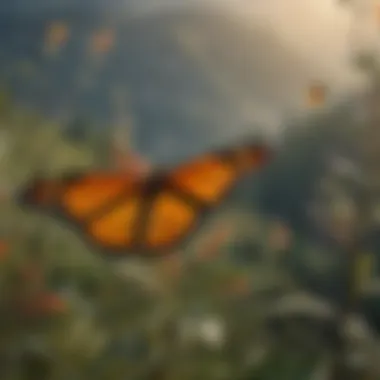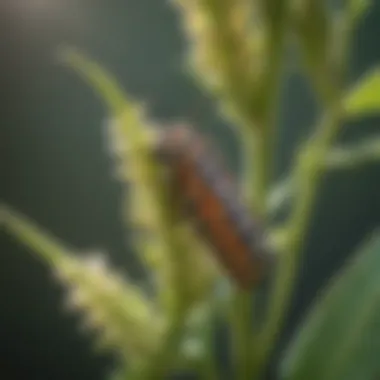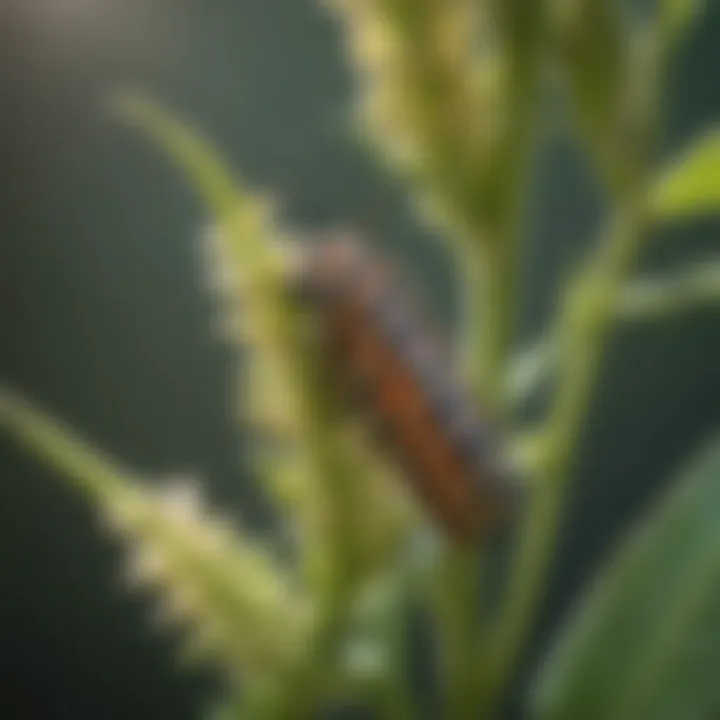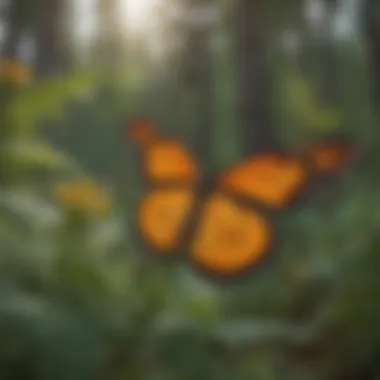Monarch Butterfly: Migration, Biology, and Conservation


Intro
The monarch butterfly, renowned for its remarkable migration and vibrant appearance, plays a critical role in woodland ecosystems. This article delves into its intricate biology, migratory patterns, and the conservation challenges it faces today. By examining the ecological significance of the monarch, its lifecycle, and the various threats to its population, we aim to underscore its importance in our natural world and the urgent need for effective conservation efforts.
Understanding Woodland Ecosystems
Woodland ecosystems are complex and rich in biodiversity. Monarch butterflies are integral to these systems, serving as pollinators for a variety of plants. Their presence is a strong indicator of the health of these ecosystems.
Environmental changes impact butterfly populations directly, influencing not just their survival but also the overall ecological balance.
Importance of Biodiversity in Forests
Biodiversity in forests is essential for ecosystem resilience. Diverse species contribute to ecosystem functions such as nutrient cycling and water filtration. This complexity allows ecosystems to adapt and thrive. Monarch butterflies, through their roles as pollinators, help maintain the plant diversity that supports other wildlife.
The reduction of biodiversity, on the other hand, can lead to ecological decline. For instance, habitat destruction limits the availability of milkweed, the primary food source for monarch caterpillars. This results in decreased populations and weakened genetic diversity.
Role of Forests in Climate Regulation
Forests serve a critical function in climate regulation by acting as carbon sinks. They absorb carbon dioxide from the atmosphere, mitigating climate change effects. This role is particularly important for organisms like the monarch butterfly, whose migratory patterns are already affected by climate fluctuations.
The decreasing forest cover impacts the microclimates where monarchs thrive. Several studies indicate that a balanced temperature and humidity level is crucial for their lifecycle stages. Monarchs rely on specific habitats during their migration for breeding and feeding, making the preservation of forests vital.
Sustainable Forestry Practices
Sustainable forestry practices are crucial to protect woodland ecosystems and the wildlife that inhabits them. By implementing these practices, we can promote both forestry productivity and ecological health.
Principles of Sustainable Forestry
Sustainable forestry focuses on maintaining forest biodiversity, productivity, and ecological processes. The principles involve selective logging, reduced impact harvesting, and habitat conservation.
Through these methods, forest managers can minimize ecological disruption while satisfying economic demands. Moreover, educating forestry professionals about ecosystem services reinforces the importance of conservation.
Case Studies of Successful Implementations
Several initiatives demonstrate the effectiveness of sustainable forestry practices.
For example, the Forest Stewardship Council has established guidelines that promote responsible forest management globally. Another case study involves the Mexico-US cross-border partnership in conserving monarch habitats through sustainable logging practices.
Woodland Stewardship Techniques
Conserving monarch butterflies and their habitats requires active woodland stewardship. This includes well-designed forest management plans and innovative conservation strategies.
Forest Management Plans
Comprehensive forest management plans integrate ecological, economic, and social objectives. These plans should prioritize maintaining habitat connectivity for migratory species like the monarch. Monitoring populations and habitat quality is also essential for adaptive management.
Conservation Strategies
Conservation strategies must focus on habitat restoration, public engagement, and research. Creating butterfly gardens, preserving milkweed, and promoting awareness are effective ways to mitigate threats to monarch populations.
"For the survival of the monarch butterfly, concerted efforts from individuals, communities, and professionals in the forestry sector are essential."
This collaborative approach will help build resilient ecosystems capable of supporting diverse species, including the monarch butterfly. Emphasizing the interlinked nature of biodiversity and conservation provides a broader perspective on the ecological challenges we face today.
Intro to the Monarch Butterfly
The monarch butterfly, a brilliant symbol of nature’s artistry, holds significant ecological value and cultural resonance. Understanding its biology, migration patterns, and conservation status is crucial for numerous reasons. The species is not merely a beautiful insect; it is an integral part of the ecosystems in which it resides. Knowledge about monarchs helps in grasping broader ecological concepts and emphasizes their role in biodiversity.
Studying monarchs offers insights into migratory behaviors that are uniquely impressive. Their annual journey spans thousands of miles and involves remarkable navigation skills. This migratory pattern is not just a feat of endurance, but also a key indicator of environmental health, showcasing how climate and habitat factors impact species survival.
The decline of monarch populations in recent decades raises alarms about ecosystem stability. This article aims to delve deep into the intricate biology and migratory behaviors of the monarch butterfly, providing a comprehensive understanding of the challenges it faces.
Defining the Monarch Butterfly


The monarch butterfly, scientifically known as Danaus plexippus, is a large, orange-and-black patterned butterfly. The uniqueness of the monarch lies in its life cycle and migratory behavior. This species undergoes a complete metamorphosis, consisting of four stages: egg, larva, pupa, and adult butterfly. Each stage plays a critical role in its life cycle and overall survival.
The coloration of the monarch serves as a warning to predators, indicating its toxicity due to the milkweed it consumes during the larval stage. The physiological characteristics, such as its size and pattern, help in its identification among other butterfly species. Monarchs are usually distinguished by their distinctive black veins and the white spots on their wings.
Historical Significance of the Monarch
Monarch butterflies have held cultural significance across various civilizations for centuries. Indigenous people in North America regard them as symbols of transformation and change. Historical records show that these insects have been captured in art, literature, and folklore.
From a scientific viewpoint, monarchs have been subjects of numerous ecological studies. Their migratory routes, particularly between North America and central Mexico, provide crucial data for understanding environmental shifts. The annual migrations have been documented since the mid-19th century, highlighting the interconnectedness of global ecosystems.
The history of the monarch butterfly is intertwined with the human story, reflecting our relationship with nature and the impact of our actions on biodiversity. Understanding this relationship is essential as we navigate conservation efforts and strive to protect formidable species like the monarch.
Taxonomy and Identification
Taxonomy and identification play a crucial role in comprehending the monarch butterfly's ecological significance and conservation needs. This systematic classification aids scientists and conservationists in understanding the interrelations among species, identifying evolutionary lineages, and ensuring effective conservation strategies. Understanding taxonomy helps clarify the butterfly's behavior, physiology, and ecological roles, strengthening the argument for its protection.
Taxonomic Classification
The taxonomic classification of the monarch butterfly, Danaus plexippus, situates it within the larger context of the butterfly family. It belongs to the order Lepidoptera, which is known for its scale-covered wings. Here’s a breakdown of its classification:
- Kingdom: Animalia
- Phylum: Arthropoda
- Class: Insecta
- Order: Lepidoptera
- Family: Nymphalidae
- Genus: Danaus
- Species: plexippus
This nomenclature is important as it highlights the connections between the monarch and other species within the Nymphalidae family, such as the viceroy butterfly, which shares ecological habitats and some behavioral traits.
Morphological Features
The morphological features of the monarch butterfly are distinct and help in its identification. Adult monarchs are easily recognized by their striking orange and black coloration. The upper sides of their wings are bright orange with black edges, while the underside is a more muted brown with lighter orange tones. This duality presents a striking visual contrast.
Key morphological traits include:
- Wingspan: Typically ranges from 3.5 to 4 inches.
- Coloration: Orange with black borders and white spots.
- Body Structure: The body is relatively stout compared to other butterflies, aiding in its long migratory journeys.
The warning coloration not only serves to attract mates but also deters potential predators, signaling that the butterfly may not be palatable due to its consumption of milkweed as a larva. These features are essential not just for identification but for understanding the monarch's role in its environment and its interactions with other species.
Life Cycle and Development
Understanding the life cycle and development of the monarch butterfly is crucial for several reasons. The monarch's life stages help to illustrate the delicate balance within ecosystems. Each phase, from egg to adult, plays a distinct role which impacts its survival and reproduction capacity. Knowledge of these stages provides insights into how environmental factors, such as climate and habitat availability, can influence population dynamics. Therefore, analyzing this life cycle sheds light on necessary conservation efforts and ecological practices essential for sustaining monarch populations.
Egg Stage
The egg stage marks the beginning of the monarch's life cycle. Female monarchs lay single eggs on the undersides of milkweed leaves, which is the exclusive food source for caterpillars once they hatch. Each egg is roughly the size of a pea and has a distinctive oval shape.
The selection of milkweed is vital; without it, the larvae cannot thrive. The eggs are vulnerable to predation and environmental conditions. During this stage, the primary factors affecting survival include temperature, moisture, and the presence of predators. Approximately four days after being laid, the eggs mature, and the larvae emerge, marking the transition to the next stage of their development.
Larval Stage
After hatching, the monarch enters the larval stage, commonly known as the caterpillar stage. This period lasts about ten days and consists of five distinct molts. The primary function during this phase is feeding. The caterpillars consume large quantities of milkweed leaves, which provide not only nourishment but also help in absorbing toxins that serve as a defense mechanism against predators.
During this stage, the caterpillar grows significantly, often increasing its weight by several times. This rapid growth emphasizes the importance of a stable food source. The more successful caterpillars are in harvesting food, the more likely they are to reach the next life stage. A challenge in this stage arises from parasitism and predation. Many have established ecological strategies to evade these threats, yet losses can still occur.
Pupal Stage
The transition from larva to pupa is one of the most critical transformations in the monarch's life cycle. Once they have completed their final molt, caterpillars seek suitable locations to form a chrysalis. This pupation takes about ten days, during which the caterpillar undergoes a remarkable transformation. Inside the chrysalis, the caterpillar's body breaks down and reorganizes to emerge as a butterfly.
This change is complex and highly sensitive to environmental conditions. Temperature and humidity can influence the duration of this stage, making it crucial for successful development. Once the metamorphosis is complete, the newly formed adult butterfly emerges from the chrysalis with its wings still crumpled and wet. It takes time for the wings to dry and expand. During this time, the butterfly is vulnerable.
Adult Butterfly
The adult stage of the monarch butterfly is the culmination of its life cycle. Upon emerging from the chrysalis, the butterfly must pump fluid into its wings to achieve full expansion. Once this is accomplished, the adult butterfly takes its first flight. The lifespan of an adult monarch varies, with some living several months, especially those that migrate.
Adult butterflies are not only remarkable for their migratory capabilities but also for their role in pollination. As they feed on nectar from various flowers, they contribute to the reproductive processes of countless plant species. Monarchs also partake in mating rituals that lead to the continuation of their life cycle, further emphasizing their importance in maintaining ecological integrity.
Migratory Behavior


The migratory behavior of the monarch butterfly is a significant aspect of its lifecycle. Understanding this behavior reveals insights into the species’ adaptations and its ecological role. Monarchs undertake a remarkable journey of thousands of miles between their breeding and wintering grounds. This migration is not only an extraordinary feat of endurance but also a crucial factor in their survival.
Migration Patterns
Monarch butterflies demonstrate highly predictable migratory patterns. Each year, millions of these butterflies travel from North America to central Mexico. This journey occurs in distinct phases, beginning in late summer or early fall.
During migration, clusters of monarchs can be observed, engaging in communal behavior. They typically follow specific routes, often resembling a funnel shape, influenced by geographical features, climatic conditions, and food availability. Some of the notable migration routes include the eastern migrations starting from as far north as Canada and the western migrations from states like California.
"The monarch's migration is an example of true geographic navigation, enhanced by environmental cues including temperature and wind patterns."
Factors such as climate changes and urban development have certain impacts on these migratory patterns. In recent years, there have been indications of a shift in migration timing, emphasizing the importance of continuous research to comprehend the long-term patterns of migration in monarchs.
Navigational Capabilities
Monarch butterflies possess remarkable navigational capabilities, which allow them to journey effectively over vast distances. Their navigation is thought to rely on several sensory modalities. Primarily, they use the sun and the Earth's magnetic field to orient themselves during migration.
Recent studies have shown that monarchs are able to adjust their migratory path according to the position of the sun, even compensating for its movement throughout the day. They also appear to utilize landmarks and possibly even odors as navigational aids. This sophisticated navigation system enables these butterflies to find their way back to the same wintering spots in Mexico year after year, despite the challenges they face.
Ecological Role and Importance
The ecological role of the monarch butterfly is multifaceted, deeply intertwined with various natural processes within woodland ecosystems. Monarchs serve vital functions that extend beyond their aesthetic appeal. Their existence contributes significantly to biodiversity, and understanding their role helps in capturing the complexity of their interactions within the environment. Protecting the monarch butterfly also indirectly shelters numerous other species that share their habitat or rely on similar ecological niches.
Pollination Contributions
Monarch butterflies play an essential role in pollination, a critical process for maintaining healthy ecosystems. As they travel from flower to flower, they facilitate the transfer of pollen, thus aiding plant reproduction. This activity promotes genetic diversity among flora, which can lead to stronger plant populations. Monarchs are particularly attracted to, and thus help pollinate, native wildflowers such as milkweed, a crucial plant not only for their lifecycle but also for overall ecosystem health. The presence of monarchs can encourage the growth of these native plants, creating a beneficial cycle.
- Benefits of Monarch Pollination:
- Increases plant reproduction rates.
- Promotes genetic diversity among plant species.
- Supports overall ecosystem resilience.
The absence of effective pollinators could lead to significant declines in flowering plant populations, affecting entire food webs.
Role in the Food Web
In addition to their role as pollinators, monarch butterflies occupy a specific niche in the food web. They are both prey and predator within their environment. As larvae, monarchs consume milkweed, which provides them with not only sustenance but also chemical compounds that make them distasteful to potential predators. This relationship enhances their survival and simultaneously influences the populations of other species that might prey upon them.
Monarchs also serve as a food source for birds, small mammals, and other insects, linking them to broader ecological interactions. Their presence helps maintain balanced predator-prey dynamics, which is vital for organic equilibrium. Thus, while they are often admired for their beauty, monarchs hold a more profound significance in ecological networks, affecting both the vegetation they pollinate and the myriad of species that interact with them directly or indirectly.
- Key Aspects of Their Role in the Food Web:
- Serve as prey, impacting predator populations.
- Control milkweed growth, thus shaping the habitat.
- Influence the abundance of plants through their pollination activities.
In summary, the ecological significance of the monarch butterfly is vast. From their contributions to pollination to their integral position within the food web, understanding their role illuminates the need for comprehensive conservation strategies to ensure their continued existence and the health of woodland ecosystems they inhabit.
Threats to Monarch Populations
Understanding the threats to monarch populations is crucial for effective conservation strategies. The monarch butterfly is a species that is not only ecologically significant but also culturally important. As migratory animals, they connect various ecosystems and symbolize natural beauty. Unfortunately, their numbers have declined significantly in recent decades.
Habitat Loss
Habitat loss is a leading cause of the decline in the monarch butterfly population. Urban development, agricultural expansion, and deforestation have resulted in the destruction of critical habitat that monarchs require at different life stages. The loss of milkweed, their primary host plant, is particularly alarming. Without milkweed, monarchs cannot lay their eggs and the larvae do not have food to develop. Matrix-like agricultural fields, devoid of native plants, further complicate their survival.
The elimination of diverse plant species must be addressed to protect monarch habitat effectively.
Pesticide Use
The use of pesticides significantly threatens monarch populations. Herbicides and insecticides, commonly used in agriculture, can harm milkweed and other plants that monarchs depend on. These chemicals disrupt the fragile balance of ecosystems and can lead to mortality in larval stages. Studies have shown that even trace amounts of certain pesticides can have lethal or sublethal effects on monarch larvae. The shift towards industrial agriculture has exacerbated this issue, leading to a reduction in habitat and an increase in pesticide application.
Climate Change Impacts
Climate change presents numerous challenges to the survival of the monarch butterfly. Altered weather patterns, increased temperatures, and shifting rainfall can disrupt their migratory patterns and breeding cycles. Monarchs rely on specific cues from their environment to migrate. Changes in the timing of blooming plants can affect their food sources during migration. Furthermore, extreme weather events such as storms or drought can devastate populations by destroying habitats. Adaptation to these rapid environmental changes poses a significant risk to their existence.


In summary, addressing these threats is vital for the survival of the monarch butterfly. Conservation efforts must focus on habitat restoration, sustainable agricultural practices, and addressing climate change impacts to ensure future generations can experience the beauty of this iconic species.
Conservation Efforts
Conservation efforts aimed at protecting the monarch butterfly are not just important but critical for sustaining its populations. The decline in monarch numbers over the past few decades has raised alarms among scientists, conservationists, and the public alike. Factors such as habitat loss, pesticide use, and climate change threaten their existence. To combat these issues, various strategies have emerged, focusing on increasing habitat availability, advocating for protective laws, and engaging local communities in conservation activities.
Habitat Restoration Projects
Habitat restoration is crucial for the monarch butterfly's survival. Monarchs rely on milkweed plants, which serve as the sole host for their larvae. Unfortunately, agricultural expansion and urban development have led to a significant decrease in milkweed and other nectar plants that adult butterflies depend on. Restoration projects focus on sеeding native plants and reestablishing milkweed habitats in both urban and rural areas.
These projects often involve collaboration between government agencies, non-profit organizations, and community groups. For example, the Monarch Joint Venture works on enhancing habitat through public awareness campaigns and by providing technical assistance to landowners. Successful restoration results not only in higher monarch populations but also benefits other species and ecosystems as a whole.
Legislative Initiatives
Legislation plays a significant role in conservation actions. Laws and policies can create frameworks for protecting habitats and restricting harmful practices. For example, the Endangered Species Act in the United States has the potential to provide legal protection for the monarch if populations continue to decline.
Furthermore, initiatives like pollinator-friendly farming policies encourage agricultural practices that sustain monarch habitats. Governments at both local and national levels are increasingly recognizing the importance of protecting monarchs and are beginning to implement programs specifically aimed at their conservation. Collaborative measures, such as the North American Pollinator Protection Campaign, highlight the importance of multifaceted approaches to encourage ecosystems that support the monarch butterfly.
Community-Based Conservation
Community involvement is often a key to successful conservation. Engaging local residents in conservation efforts fosters a sense of responsibility and awareness about the challenges facing monarchs. Community-based conservation initiatives can take many forms, from educational programs to local wildlife habitat enhancement projects.
One example includes Citizen Science projects. People of all ages participate in monitoring monarch populations and their migration patterns. This not only provides valuable data for researchers but also enhances public interest and investment in conservation efforts. Additionally, local gardening groups encourage planting native species, including milkweed, thus directly supporting monarch habitat.
In summary, conservation efforts require a comprehensive strategy that combines habitat restoration, legislative action, and active community participation. This multifaceted approach will ensure the survival of the monarch butterfly for future generations.
"Conservation is a journey, not a destination. Our understanding and efforts must evolve continually."
By emphasizing the importance of these efforts, we foster a collective action that could secure the future of the monarch butterfly.
Role of Research and Education
Effective conservation of the monarch butterfly relies heavily on ongoing research and education. This duo plays a crucial role in enhancing our understanding of this species and the factors affecting its survival. Both scientific studies and educational outreach are essential to foster informed conservation strategies. These strategies can help mitigate threats such as habitat loss and climate change.
Research provides valuable insights into the biology and migratory behavior of the monarch butterfly. For instance, data collected through scientific studies can illuminate the patterns of migration and highlight the specific environmental conditions that are critical for the species’ lifecycle. Furthermore, research fosters collaboration among conservation organizations, governments, and communities, leading to more sustainable practices and policies.
Scientific Studies and Findings
Scientific research has revealed many aspects of the monarch butterfly's biology and migration. Recent findings emphasize the significance of particular habitats, such as milkweed, which is vital for the caterpillar stage. A detailed examination of migration patterns shows how the butterflies navigate and the factors influencing their routes. This includes climatic conditions and availability of food sources. Studies often utilize tracking technologies, which allow researchers to follow the butterflies’ journeys in real-time, further enhancing our understanding of their environmental needs.
Moreover, genetic studies have uncovered a diverse range of monarch populations across North America. This genetic diversity is essential as it contributes to the resilience of the species against changing environmental conditions. Research also highlights how broader ecological dynamics, including changes in flora and fauna, can impact monarch populations. This knowledge is vital in forming effective conservation strategies.
"Research on the monarch butterfly not only enlightens us about this specific species but also holds broader implications for ecological conservation overall."
Public Awareness and Engagement
Public engagement is an essential component of conservation efforts for the monarch butterfly. Increasing awareness can mobilize communities to take action in preserving natural habitats. Educational programs and outreach initiatives have proven effective in informing people about the importance of the monarchs and the challenges they face.
Engagement can take many forms, from workshops and seminars to social media campaigns. Collaboration with schools, organizations, and local communities can foster a deeper connection to nature. Providing accessible information about the monarch butterfly encourages individuals to participate in conservation efforts, such as planting native milkweed in gardens and advocating for sustainable land-use practices.
Moreover, platforms like Facebook and Reddit have been utilized to create communities focused on butterfly conservation. Sharing personal stories about observing monarchs can build a collective understanding of their beauty and importance. Grassroots movements often lead to larger initiatives, which can influence policy changes at local and state levels.
Increasing public awareness not only supports the monarch butterfly conservation but also promotes a more profound respect for biodiversity as a whole. Engaging a wider audience is a fundamental step toward fostering a culture of conservation.
The End
The conclusion of this article serves as a critical summation of the multifaceted relationship that exists between the monarch butterfly and its environment. By reflecting on the various aspects discussed throughout the article, we highlight not only the biological significance of this species but also the urgent need for its conservation. Monarch butterflies are intricate organisms whose life cycles, migratory behaviors, and ecological roles cannot be understated. Each point discussed reinforces the idea that their existence is deeply woven into the fabric of our ecosystems.
Summary of Findings
In summarizing the key findings of this investigation, several points emerge:
- Biological Significance: The monarch butterfly exhibits a highly complex life cycle characterized by distinct stages: egg, larval, pupal, and adult. Each stage plays a vital role in the overall health of the species.
- Migration: Their migratory behaviors are exceptional, as the butterflies travel thousands of miles between breeding and wintering habitats, showcasing an intricate navigational ability.
- Ecological Impact: Monarchs contribute substantially to pollination processes, making them an important species for many plants within their ecosystems.
- Threats and Challenges: Habitat loss, pesticide use, and climate change are significant threats to their survival. The ongoing decline in monarch populations illustrates the precarious balance of our ecosystems.
Call to Action for Conservation
The challenges faced by monarch butterflies necessitate immediate action from various stakeholders, including conservationists, policymakers, and the general public. Actions that can be taken include:
- Advocacy for Habitat Restoration: Engage in or support local and national initiatives aimed at restoring and preserving the habitats that monarchs depend on.
- Promoting Sustainable Practices: Encourage the use of organic farming methods that reduce pesticide use and protect vital habitats.
- Education and Awareness: Share knowledge about the importance of monarch butterflies in ecosystems. By fostering public awareness, communities can rally support for conservation efforts.







